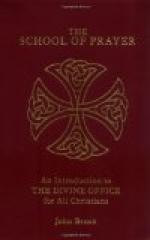The Roman Breviary is excellent, too, in comparison with every other breviary (e.g., Aberdeen, Sarum, Gallican). For none of these can show the antiquity, the authority, the doctrine, the sublime matter, the beautiful order, which the Roman Breviary presents. It was for these reasons that the emperors, Pepin (714-768), Charlemagne (742-814), Charles the Bald (823-888), adapted the Roman rite (Gueranger, Institutiones Liturgiques, tom. i.). And Grandicolas (1772), an erudite liturgist, but a prominent Gallican with no love for Roman rites, declared that the Roman Breviary stands in relation to other breviaries as the Roman Church stands in relation to all other Christian bodies, first and superior in every way (Com. Hist. in Brev. Rom., cap. 2). St. Francis De Sales applied to his Breviary the words of St. Augustine on the Psalter, “Psalterium meum, gaudium meum.”
CHAPTER IV.
THE CONTENTS OF THE BREVIARY.
SECTION I.
The title of the Breviary is, BREVIARIUM ROMANUM EX DECRETO SACROSANCTI CONCILII TRIDENTINI RESTITUTUM S. PII V. PONTIFICIS MAXIMI JUSSU EDITUM, ALIORUMQUE PONTIFICIUM, CURA RECOGNITUM PII PAPAE X., AUCTORITATE REFORMATUM. This work is divided into four parts, the first part being called Pars Hiemalis, the winter part; the second part, Pars Verna, the spring part; the third part, Pars Aestiva, the summer part; and the fourth part, the Pars Autumnalis, the autumn part.
The Church, guided by the Holy Ghost, has drawn up these volumes of liturgical prayer, so that for each season, even for each day, her official prayer may be suited to the time, to different degrees of solemnity and of rite, and so that it may be fixed and determined, yet having great beauty in its wonderful unity and variety. Hence, nothing in her official prayer is left to chance, nothing is left to the selection or caprice of the individual who recites this prayer; all is foreseen, everything is in order, every tittle has a reason for its existence and its place in the liturgy, and represents the end and the intentions of the Church. For, every part of the Roman Breviary is stamped with the wisdom, the zeal and the piety of the Church, which presents it, as an offering all suitable for and worthy of God’s honour and glory.
Considering, then, the Breviary as a liturgical book, we find that the Divine Office has four general divisions, corresponding to the divisions of our Lord’s life. First, from Advent to Septuagesima; second, from Septuagesima to Easter; third, from Easter to Pentecost; fourth, from Pentecost to Advent. These divisions correspond also to the divisions of the year, winter, spring, summer and autumn.




